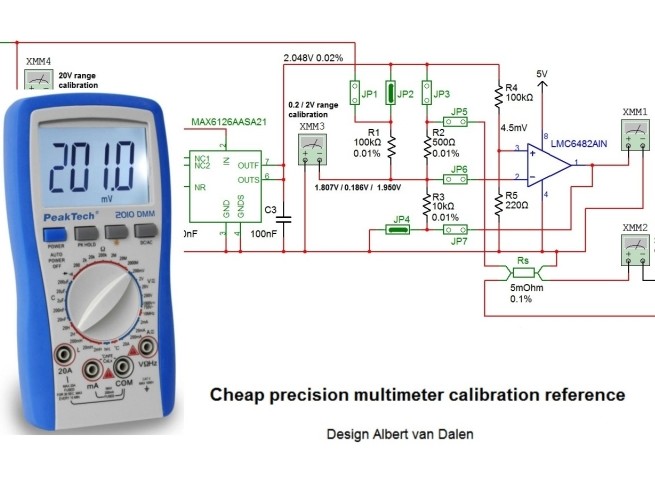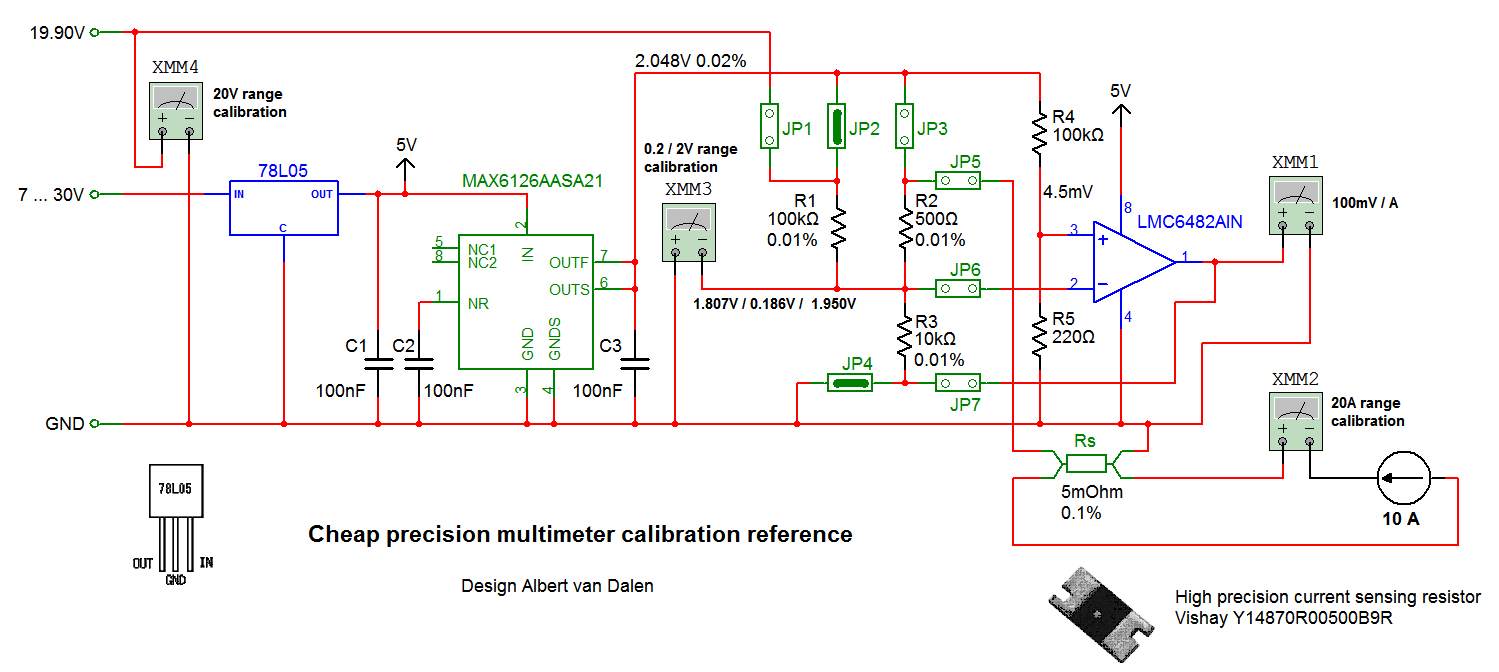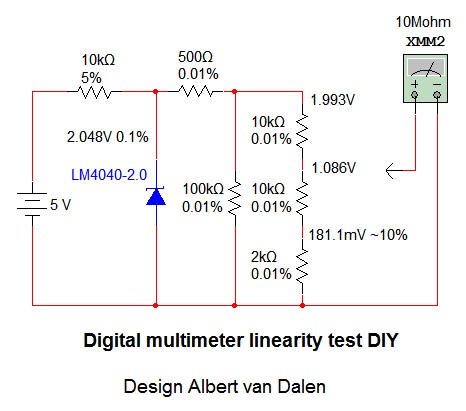DIY voltage & current reference standard
- Why calibrate a multimeter?
- Required precision components for the calibration reference
- DC voltage reference accuracy
- DC voltage range calibration procedure
- DC voltage range calibration result
- DC 10A range calibration accuracy
- DC 10A range calibration procedure
- DC 10A range calibration result
- Resistance range calibration
- Linearity check
- Calibration limitations
- Mechanical and electronic tolerances compared
- Calibration links
I have developed a cheap multimeter calibration reference by which you can calibrate a digital multimeter yourself. Here we calibrate my favorite multimeter, the PeakTech 2010, it has a lot of features and it cost just €35.
 Precision multimeter calibration reference
Precision multimeter calibration reference
 Digital multimeter DC voltage calibration DIY
Digital multimeter DC voltage calibration DIY

Why calibrate a multimeter?
To ensure accurate measurement results, a multimeter must be calibrated periodically. For companies, calibration of instruments is usual and even mandatory. For hobbyists, it is expensive. The calibration of a multimeter can even be more expensive than buying a new one.
Required precision components for the calibration reference
Effort has been made to reduce the number of precision components, the total costs for the calibration circuit are about €30.
- 1 x MAX6126AASA21 Voltage: 2.048V 0.02% (€6)
- 1 x 500Ω 0.01% (€6)
- 1 x 10kΩ 0.01% (€6)
- 1 x 100kΩ 0.01% (€6)
- 1 x Current sensing resistor 5mΩ / 1W / 0.1% Vishay Precision Group Y14870R00500B9R (€4)
- 1 x 10kΩ 0.01%
- 1 x 2kΩ 0.01%
To save costs, you can take resistors of 0.1% instead of 0.01%, which costs about €0.30. Also you can use the LM4040-2.0, which has an accuracy of 0.1% and cost about €1.50. This decreases the voltage and 10A current calibration accuracy to 0.3%.
DC voltage reference accuracy
The DC voltage accuracy of the PeakTech 2010 is ±0,5% rdg. + 3dgt. The calibration standard should have an accuracy of less than 1/4 of the accuracy of the device being calibrated. So the accuracy should be at least 0,5% / 4 ~ 0.1%. With the use of a 0.02% precision voltage reference MAX6126AASA21 and 0.01% resistors we achieve these reference voltage accuracies:
| Accuracy [%] | ||
| 0.186V ref | 0.04 | |
| 1.950V ref | 0.02 | |
| 19.88V ref | 0.04 | The accuracy of the 1.807V measurement is taken into account |
DC voltage range calibration procedure
Note that the input resistance of the multimeter (10MΩ) is taken into account here. The steps must be followed in this order:
- 0.2V range
Insert jumper JP2 and JP4. The reference voltage XMM3 = 186.2mV - 2V range
Insert jumper JP3 and JP4. The reference voltage XMM3 = 1.950V - 20V range
Insert jumper JP1 and JP4. Connect an adjustable voltage supply of 19.90V according the circuit and measure XMM3. Adjust the voltage supply so that XMM3 = 1.807V. The voltage supply is 19.88V now. Because of the 1.807V measurement, the 2V range measurement error from the previous step must be corrected here.
DC voltage range calibration result
| PeakTech 2010 voltage range errors | ||||
| 0.2V range | ||||
| Error [%] | Reading [V] | Reference [V] | CF | |
| DUT1 | 0.00 | 0.186 | 0.186 | 1.0000 |
| DUT2 | 0.22 | 0.186 | 0.186 | 0.9979 |
| 2V range | ||||
| Error [%] | Reading [V] | Reference [V] | ||
| DUT1 | -0.26 | 1.945 | 1.950 | 1.0026 |
| DUT2 | 0.56 | 1.961 | 1.950 | 0.9944 |
| 20V range | ||||
| Error [%] | Reading [V] | Ref. = 19.90V x CF [V] | ||
| DUT1 | -0.31 | 19.89 | 19.95 | 1.0031 |
| DUT2 | 0.21 | 19.83 | 19.79 | 0.9979 |
| 40V at 200V range | ||||
| Error [%] | Reading [V] | Ref. = 2 x 19.99V x CF [V] | ||
| DUT1 | -0.26 | 40.00 | 40.10 | 1.0026 |
| DUT2 | 0.01 | 39.90 | 39.90 | 0.9999 |
| CF = correction factor | ||||
| Value = reading x CF | ||||
DC 10A range calibration accuracy
The PeakTech 2010 accuracy of the DC 20A range is just ± 2,0% rdg. + 5 dgt. For the simple hub motor test stand, a higher accuracy was required. We use a high precision current sense resistor from Vishay Precision Group: Y14870R00500B9R, 5mohm, 0.1%, 1W. The overall accuracy of the 10A current calibration circuit is 0.12%. The current is limited to about 10A because of the maximum power of the shunt.
DC 10A range calibration procedure
Insert jumpers JP5, JP6 and JP7.
Apply a DC current of about 10A in series with the shunt and the multimeter under test, according to the circuit.
Take the LM6482 offset voltage into account, so measure the voltage change at XMM1.
The current is U * 10.00.
DC 10A range calibration result
| PeakTech 2010 10A range error | |||||
| 10A range | |||||
| Error [%] | Reading [A] | Reading [V] | Offset [V] | A = CF * (V-offset) / 0.1 | |
| DUT1 | 0.19 | 8.00 | 0.893 | 0.097 | 7.984 |
| DUT2 | 0.45 | 7.96 | 0.887 | 0.097 | 7.924 |
Resistance range calibration
The resistor measurement accuracy of the PeakTech 2010 is ±0,8% rdg. + 3dgt in most ranges. This accuracy can be increased simply by calibrating with 0.1% resistors.
| R [Ω] | DUT [Ω] | DUT error [%] |
| 180.0 | 179.7 | 0.167 |
| 1800 | 1799 | 0.056 |
| 19230 | 19230 | 0 |
| 178000 | 178000 | 0 |
Linearity check
Integrating analog to digital converters, used in DMM, are inherently linear. But due to dielectric absorption in the integrating capacitor and the slew rate of both the integrator and comparator, very small linearity errors can occur near zero and full-scale. Therefore the ADC linearity has to be checked especially at 10% and 90% of full scale.
Note that the resistor network has to be turned over for the 90% level test.
Calibration limitations
- It is not necessary to do adjustments inside the multimeter, often this is not possible. It is sufficient to correct the DMM reading with a correction factor obtained with the calibration.
- The AC measurement ranges are not calibrated here, but this is not a big problem because in practice, just DC voltages need to be measured accurate.
Mechanical and electronic tolerances compared
In the electronics world, a resister tolerance of 0.1% is very accurate, in the mechanical world, 0.1% is nothing special. Building a cabinet of 1m wide must be done with at least 0.5mm accuracy, else it is hopeless. This is a tolerance of 0.05%. The automotive industry works with very small tolerances: the cylinder bore tolerance on modern engines is about 0.005%.
Calibration links



